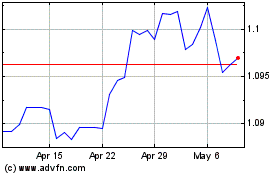Australian Dollar Climbs After RBA Keeps Rate On Hold
03 July 2018 - 1:00PM
RTTF2
The Australian dollar strengthened against its major
counterparts in the Asian session on Tuesday, trimming its early
losses, after Australia's central bank decided to leave its key
interest rate unchanged at a record low, consistent with its aim of
"sustainable growth in the economy and achieving the inflation
target over time."
The decision was widely expected.
The board of the Reserve Bank of Australia, governed by Philip
Lowe, voted to maintain the cash rate at 1.50 percent. The bank had
reduced the rate by 25-basis points each in August and May last
year.
"The Board judged that holding the stance of monetary policy
unchanged at this meeting would be consistent with sustainable
growth in the economy and achieving the inflation target over
time," the bank said in a statement.
The bank reiterated the low level of interest rates is
continuing to support the Australian economy. Further progress in
reducing unemployment and having inflation return to target is
expected, although this progress is likely to be gradual, RBA
said.
Data from the Australian Bureau of Statistics showed that
Australia building approvals fell a seasonally adjusted 3.2 percent
on month in May, coming in at 17,791.
That was shy of expectations for a flat reading following the
5.0 percent decline in April.
Asian stock markets were mostly lower, as worries about trade
wars between the U.S. and other major economies weighed on investor
sentiment. Tariffs on $34 billion worth of Chinese imports to the
U.S. and a matching $34 billion worth of U.S. exports to China are
due to take effect on July 6.
The aussie dropped against its most major opponents on Monday,
as lingering trade worries, falling oil prices, soft Chinese
manufacturing data and German political uncertainty dampened risk
sentiment. It lost 0.7 percent against the yen, 0.9 percent against
the greenback and 0.6 percent against the euro for the day.
The aussie bounced off to 0.9714 against the loonie and 0.7373
against the greenback, from its early lows of 0.9661 and 0.7314,
respectively. The next likely resistance for the aussie is seen
around 0.98 against the loonie and 0.75 against the greenback.
The aussie firmed to 1.0977 against the kiwi, its highest since
January 31. If the aussie continues its rise, 1.11 is possibly seen
as its next resistance level.
The aussie edged up to 1.5801 against the euro, after having
fallen to near a 2-month low of 1.5888 at 9:45 pm ET. The aussie is
seen finding resistance around the 1.56 level.
Following a low of 81.03 hit at 9:45 pm ET, the aussie reversed
direction and rose to 81.82 against the yen. Next key resistance
for the aussie is likely seen around the 83.00 level.
Data from the Bank of Japan showed that Japan monetary base
advanced 7.4 percent on year in June, coming in at 493.363 trillion
yen.
That follows the 8.1 percent gain in May.
Looking ahead, U.K. construction PMI for June and Eurozone
retail sales and PPI for May are due in the European session.
In the New York session, U.S. factory orders and durable goods
orders for May will be out.
AUD vs NZD (FX:AUDNZD)
Forex Chart
From Apr 2024 to May 2024

AUD vs NZD (FX:AUDNZD)
Forex Chart
From May 2023 to May 2024
